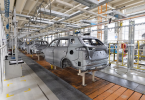Last Friday, we were surprised by the bomb that, a year and a half after its original announcement in the iPhone X keynote, AirPower will never see the light of day. Apple officially gave up the project.
The news was first given to TechCrunch, through a brief statement by Dan Riccio, Apple’s senior vice president of hardware engineering:
After much effort, we concluded that AirPower will not meet our high standards and we canceled the project. We apologize to customers who were excited about this release. We continue to believe that the future is wireless and we are committed to driving the wireless experience.
If Riccio signed, it is he who took the blame for the failure at Apple. It was probably the one who gave the green light for Phil Schiller to announce the product in September 2017, before it was really ready to hit the market.
And that was basically Apple’s single biggest mistake in this whole story: announcing to the world, and still in a keynote of new iPhones, an unfinished product. Also, if we stop to think, there is no need for the company to announce something so far in advance; she can always choose the best time to do this, according to the internal progress of each project.
At times, it may be strategically or commercially good for Apple (or other companies) to announce something in advance. The Apple TV + service, for example, is not at any risk; it does not depend on any special technology, contracts have been signed and several of those own productions that we saw in the keynote have already been filmed and are now in the post-production phase.
But what really went wrong with AirPower, anyway?
The Product
To say that AirPower would simply be a wireless recharge base capable of powering three devices, like several that already exist today in the market, is very shallow.
Yes, in practice, roughly, that was it: AirPower would be an oval-shaped white base capable of recharging an iPhone , an Apple Watch, and the AirPods recharging case simultaneously. But to put its brand in this product, Apple wanted – as usual – to do something different and, above all, better.
All recharge bases on the market today have one, two or even three electromagnetic reels for wireless recharge using the Qi standard. This means that each device placed on them needs to be positioned correctly in the center of each coil for communication to be established.
Inside AirPower, Apple wanted to put more than 20 (!) Of these reels – in a layout more or less as it shows the design of this patent:
Smartly, the base would then detect the coil’s best-positioned device and activate only it. With this, the user would no longer have to worry about the exact position or the order that would “throw” his iPhone, Apple Watch and/or AirPods over AirPower; the motto would be the apple classic, “just works”.
As cake cherry, Apple would also implement a communication system between the devices placed on the AirPower, so that the iPhone screen could show the level of charge of each of them. Very nice.
Obviously, it should also be noted here that Apple Watch uses a proprietary induction recharge system (not Qi, such as the iPhone and the new AirPods). That is, the vast majority of these generic recharging bases on the market is not able to feed it.
Hypotheses of what went wrong
Riccio’s statement, of course, was rather vague. A product not meeting the “high standards” imposed by Apple can mean a number of things.
Here are the most obvious hypotheses, as a basis for what we have heard in recent months :
- Even with all the engineering and intelligent management of coil activation, the product was overheating. Electronics to warm up is normal, especially those that deal with energy, but only up to a certain point; and in the case of such a product, the heat could even negatively interfere with the performance of the recharge itself.
- The idea of the 21-24 internal coils could be fantastic to solve the problem that sometimes devices do not recharge because they are poorly positioned, but this entailed a lot of internal interference in AirPower – again, damaging its performance.
- Such a communication feature between the devices positioned on the base was rather “buggy”, showing on the iPhone screen inconsistent values of their level of recharge without a satisfactory level of accuracy.
Of the three points above, certainly the first would be the most serious. Many people leave these bases of recharge on bedside tables, and they can not even think of a device that knows how to catch fire and set a house on fire. The Galaxy Note7 lesson was not just given to Samsung.
So far, we are talking about technical difficulties that in theory should be overcome by Apple, sooner or later. Apparently, if the motive was one or several of these, the laws of physics still have their strength. Some products are sometimes designed “ahead of time”.
But these are not the only hypotheses. The iFixit staff, for example, looked at the entire case and is almost certain that Apple was able to fabricate fully functional AirPower units in their labs. The problem, they said, would have to do with electromagnetic interference and the various regulations imposed by American and European bodies.
William Lumpkins, engineering vice president at O & S Services, explains that the electromagnetic fields emitted by multiple coils within AirPower could act like waves when they collide, generating what they call “harmonic frequencies” – whose challenge grows in proportion to a number of interleaved coils.
Over time, these harmonics add up and become really powerful signals in the air. And that can be bad – you can even disable someone’s pacemaker if the level is too high. Or it may short-circuit hearing aids.
There was also someone who had bet that the cost of AirPower would be too high and that Apple gave up for it. Rumors ranged between $ 150 and $ 200, but in my opinion, even if Apple had to sell it at $ 250 (which would be absurd), that is not enough reason for her to cancel the project.
And now?
Well. As you might have noticed, I can not pin them an exact answer to the question asked in the title of this article; only Apple could answer that for sure, and it will hardly do.
The cancellation of AirPower is a milestone in Apple’s history because there is no other recent case of a product of it, especially hardware like that, have been announced and then aborted. The only similar example I can now recall was a promise made by Steve Jobs in 2010to make FaceTime an open standard (which has not materialized to date, probably because of legal issues ); but, without a doubt, it is something quite different.
On the other hand, much of the media and all the mass of Apple’s haters want and will try to make this case something bigger than it really is. The biggest mistake of Apple in this whole story, as I said at the beginning of the article, was to have announced the product ahead of time. Canceling a project, whatever the reason, is not uncommon in large companies like Apple. Since the announcement of AirPower, this must have happened several times in there without us even being aware of such projects. And this is how it has to be.
In addition, even if you and many of us were anxious for the arrival of AirPower, the product itself would not cease to be simply a base of wireless recharge with some improvements and differentials in relation to what we already have in the market today. It would definitely not be a product that would move some needle out of the billions that Apple makes every year. The damage to it here is totally intangible, not financial.
Let this all serve as a lesson for the company and do not re-occur such an embarrassment anytime soon. There is also the cheerleader, who knows from time to time to surprise with the launch of an “AirPower 2” rethought and even better than it would be that product that will never reach our hands. The work continues.
See More:For the Third Time this Year, Apple Cuts iPhones Prices in China








